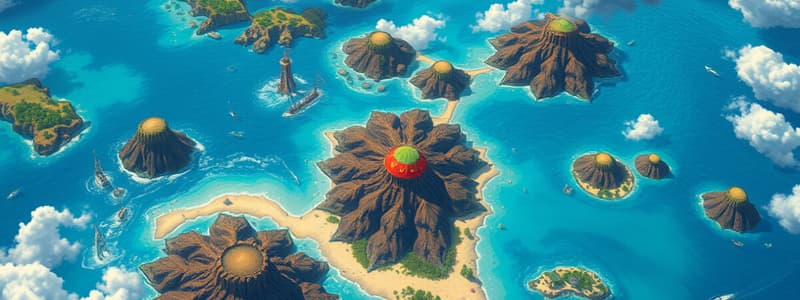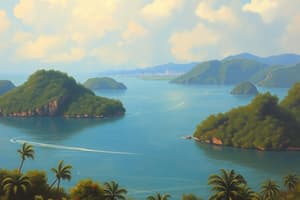Podcast
Questions and Answers
What is the predominant religion in the Caribbean?
What is the predominant religion in the Caribbean?
- Protestantism
- Catholicism (correct)
- Islam
- Buddhism
Which of the following is the largest lake in the Caribbean?
Which of the following is the largest lake in the Caribbean?
- Lake Enriquillo (correct)
- Lake Titicaca
- Lake Maracaibo
- Lake Nicaragua
Which of the following islands is not one of the three largest in the Caribbean?
Which of the following islands is not one of the three largest in the Caribbean?
- Jamaica
- Cuba
- Puerto Rico (correct)
- Hispaniola
What is the estimated population of the Caribbean?
What is the estimated population of the Caribbean?
What is the highest point in the Caribbean?
What is the highest point in the Caribbean?
What was the primary motivation for European migration to the Caribbean, Central America, and South America in the late 1400s?
What was the primary motivation for European migration to the Caribbean, Central America, and South America in the late 1400s?
Which mountain range is recognized as the longest in Central America?
Which mountain range is recognized as the longest in Central America?
Which lake is the largest in Central America?
Which lake is the largest in Central America?
What is a significant effect of European colonization on the cultures of the Caribbean, Central America, and South America?
What is a significant effect of European colonization on the cultures of the Caribbean, Central America, and South America?
Which country lost a significant portion of its territory after fighting a war with Texas and the United States?
Which country lost a significant portion of its territory after fighting a war with Texas and the United States?
Which mountain is the highest in political Europe?
Which mountain is the highest in political Europe?
What is the largest canyon in Europe?
What is the largest canyon in Europe?
Which river is considered the longest in Europe?
Which river is considered the longest in Europe?
What catalyzed the formation of the European Union?
What catalyzed the formation of the European Union?
Which ancient civilization is credited with the concept of citizenship?
Which ancient civilization is credited with the concept of citizenship?
Which of the following rivers is highlighted as a significant trade route in Europe?
Which of the following rivers is highlighted as a significant trade route in Europe?
What major event significantly altered the borders of Europe post-World War I?
What major event significantly altered the borders of Europe post-World War I?
What is the capital of Brazil?
What is the capital of Brazil?
Which of these regions in South America is characterized as a grassland region?
Which of these regions in South America is characterized as a grassland region?
What major civilization was centered in the Andes before Spanish conquest?
What major civilization was centered in the Andes before Spanish conquest?
What has been a significant challenge in the Amazon Basin?
What has been a significant challenge in the Amazon Basin?
Which statement describes the conditions of Indigenous people in Bolivia following Evo Morales' election?
Which statement describes the conditions of Indigenous people in Bolivia following Evo Morales' election?
Which country primarily represents the Southern Cone region?
Which country primarily represents the Southern Cone region?
What is the predominant industry in the Gran Chaco region?
What is the predominant industry in the Gran Chaco region?
What was a significant consequence of Spanish colonization in South America?
What was a significant consequence of Spanish colonization in South America?
Flashcards are hidden until you start studying
Study Notes
Caribbean Region
- Comprises around 7,000 islands; surrounded by the Atlantic Ocean, Caribbean Sea, and Gulf of Mexico.
- Volcanic origins with ongoing volcanic activity; Pico Duarte is the highest point.
- Lake Enriquillo in Hispaniola is the largest lake; Cauto River in Cuba is the largest river.
- Estimated population: approximately 36 million; Spanish is the predominant language, while Catholicism is the main religion.
- Diverse ancestry includes African/Caribbean, European/Caribbean, and indigenous tribes like the Arawak and Tainos.
Central America
- Acts as an isthmus connecting North America and South America, with significant mountainous regions.
- Notable geographic features: Lake Nicaragua (largest lake) and Rio Coco (longest river).
- Rainforests and the second largest coral reef are present, supporting biodiversity.
- Population is roughly 43 million, primarily Spanish-speaking; English is official in Belize.
- Catholicism is the major religion; historically impacted by European colonization and Cold War conflicts.
South America
- Fourth largest continent; home to the Amazon Rainforest and Amazon River, the world's largest.
- Angel Falls are the tallest waterfalls; the Andes Mountains form the longest mountain range globally.
- Population around 380 million; Spanish is primary language, with Portuguese spoken by about 50% of the population.
- Predominantly Catholic, reflecting colonial influence; diverse cultures shaped by African heritage and indigenous tribes.
Migration Patterns
- Defined as the movement of people, significantly influenced by natural resources and climate.
- European migration began in the late 1400s, driven by the search for resources; often devastating for native populations.
- Climate effects: population concentration in cooler coastal areas; South America's dense population mainly in moderate climates.
Cultural Influences
- Caribbean, Central and South American cultures deeply shaped by European colonization and African heritage.
- Mestizo population predominates, reflecting Spanish and Native American descent; Catholicism is widely practiced.
- Candomblé in Brazil showcases African cultural retention; recognition of indigenous heritage persists, particularly around historical tribes.
Historical Context of Mexico
- Indigenous civilizations like the Mayans and Aztecs preceded Spanish conquests.
- Hernan Cortes' invasion led to the fall of the Aztec Empire and the establishment of Mexico City.
- After 300 years of Spanish rule, Mexico gained independence; significant territorial losses to Texas and the U.S.
- Modern-day Mexico consists of 32 states and predominantly features two major political parties: PRI and PAN.
Central American Nations
- Comprises Costa Rica, Belize, Guatemala, Panama, Nicaragua, Honduras, and El Salvador.
- Nicknamed "banana republics" due to instability and dependence on agriculture.
- Spanish colonization made Catholicism the dominant religion; indigenous tribes faced significant cultural upheaval.
- The Cold War's impact led to extensive conflicts in the region.
Caribbean South America
- Includes Colombia, Venezuela, Guyana, and French Guiana, with coastal access to the Caribbean Sea.
- Spanish colonization influenced language and religion; both countries are major Spanish-speaking nations.
- Venezuela faces ongoing political crises; Colombia operates as a democracy amid its turbulent history.
- Guyana and French Guiana maintain Caribbean cultural ties, despite historical Dutch and British colonial influences.
Brazil Overview
- Largest country in South America, fifth-largest worldwide; capital Brasília has a population of 4.2 million.
- Total population of about 212.6 million; diverse ethnic and religious backgrounds, primarily Roman Catholic.
- Government divided into Executive, Legislative, and Judiciary branches; significant history of Native Brazilian struggles.
- Brazil is renowned for tourism and sporting prowess, notably in football.
Geographic Regions: Andes and Pampas
- Andes mountain range stretches from Venezuela to Chile and Argentina, rich in biomes and significant for the Inca civilization.
- Spanish colonizers exploited Inca wealth through silver mining, leading to social disparities for Indigenous populations.
- The Pampas region, characterized by grasslands in Argentina, Uruguay, and Brazil, is known for its cattle ranching and gaucho culture.
Amazon Basin Challenges
- Spans multiple South American countries; sparsely populated with various Indigenous nations.
- Faces political challenges regarding resource extraction and environmental preservation.
- Represents a complex interplay of human history and ecological diversity.
Southern Cone
- Defines a cultural and geographic area including Argentina, Chile, Uruguay, Paraguay, and parts of Brazil.
- Historically shaped by Indigenous nations, Spanish colonization, and the influence of the Inca Empire.
- Independent since the 19th century; European immigration diversified the populace.
- Political turmoil through dictatorships in the 20th century has influenced societal identity and development.
Gran Chaco Region
- Arid to semi-arid area shared by Argentina, Bolivia, and Paraguay; historically underpopulated and overlooked by Spanish colonizers.
- Contains a rich history of land disputes and settlements, particularly by Mennonite communities from Canada and the USSR.
- Cattle ranching remains the primary economic activity, while infrastructure development has been slow.
Landforms and Political Geography of Europe
- Includes diverse features such as mountains (Alps), valleys (Loire and Rhone), canyons (Tara River Canyon), and rivers (Danube).
- Political boundaries shaped significantly by historical events, including wars and territorial conflicts.
- Ancient Greece and Rome's governance ideals continue to influence modern Europe.
- The formation of the EU represents a effort for unity and collaboration amidst a complex historical backdrop, including the remnants of empires.### Political Controversies and EU Evolution
- Political tensions in the EU stem from financial bailouts, loss of sovereignty, and immigration issues from Eastern Europe.
- The EU emerged post-World War II to enhance cooperation among Western European economies.
- It has become a significant institution impacting everyday life in its 25 member states, influencing currency and foreign policy.
Common Foreign and Security Policy (CFSP)
- Focuses on enhancing international stability, security, democracy, and human rights.
- Aims to stimulate prosperity and uphold the rule of law.
- Instruments used by CFSP include sanctions, conflict prevention, mediation, weapons control, and crisis management.
Common Security and Defense Policy (CSDP)
- Serves as the EU's tool for international crisis management using military and civilian resources.
- Addresses conflict prevention, support for fragile states, and humanitarian efforts.
European Neighbourhood Policy
- Encourages partnerships with neighboring countries focusing on democracy and international law.
- Offers financial support, market access, and technical assistance to partner nations.
Foreign Policy Coordination
- The High Representative for Foreign Affairs & Security Policy oversees EU's foreign policy efforts.
- The Foreign Affairs Council discusses foreign policy matters monthly.
- The European External Action Service (EEAS) manages diplomatic issues and promotes EU interests abroad.
Cultural Overview of Europe
- Europe, diverse with around 50 countries, exhibits significant cultural variation alongside common traits.
- Family time is valued, and historical perspectives differ from the U.S. regarding building ages.
- European culture is typically less individualistic; higher taxes are seen in the context of collective welfare.
Social and Political Climate
- European politics are generally more liberal than in the U.S., emphasizing human rights and social responsibility.
- Attitudes toward alcohol are relaxed, with familial underage drinking socially acceptable.
- Religious affiliation is diverse, with Christianity as the predominant faith.
Educational Systems in Europe
- Education often follows a common core structure until around age 14, differing from more specialized or varied systems.
Western Europe Insights
- Includes economically developed countries like the UK, France, and Germany with major financial centers in London and Paris.
- City life is typically fast-paced compared to more relaxed rural areas, emphasizing strong social safety nets.
Mediterranean and Eastern Europe
- Mediterranean life, characterized by lengthy family meals and a strong emphasis on religion, incorporates afternoon siestas into daily routines.
- Eastern Europe combines traditional rural lifestyles with increasing urbanization while maintaining friendly cultural interactions and significant government economic roles.
Language and Cultural Connections
- Language trees illustrate relationships among languages, akin to family trees for people, highlighting migration and settlement patterns across regions.
Studying That Suits You
Use AI to generate personalized quizzes and flashcards to suit your learning preferences.




